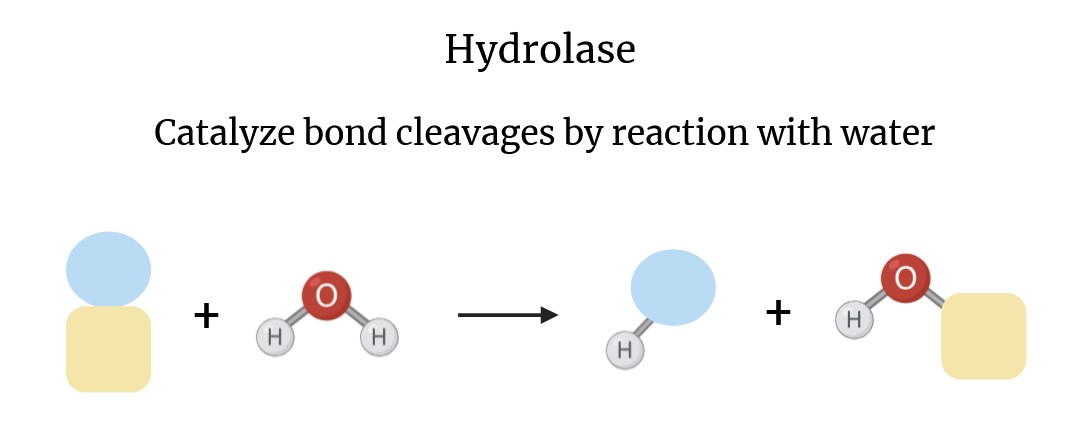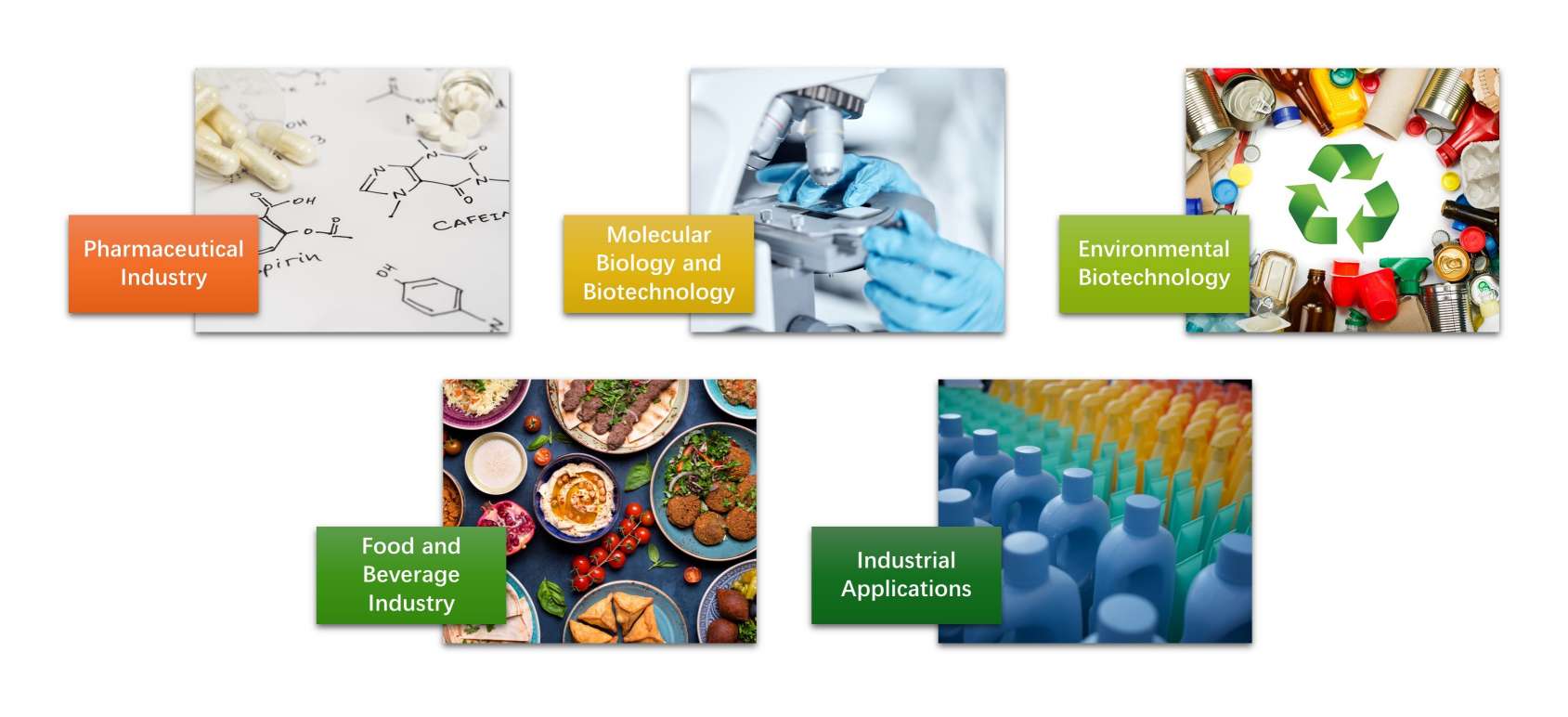Our Products Cannot Be Used As Medicines Directly For Personal Use.


Welcome! For price inquiries, please feel free to contact us through the form on the left side. We will get back to you as soon as possible.
Hydrolases are a large and diverse class of enzymes that play a fundamental role in the biochemistry of living organisms. These enzymes catalyze the hydrolysis of chemical bonds, a process in which a water molecule is used to break down substrates into simpler components. Hydrolases are involved in a variety of biological processes, including digestion, metabolism, signal transduction and regulation of cellular activities. Because of their versatility and ubiquity, hydrolases are extensively studied and used in various industries, including pharmaceuticals, biotechnology, food production, and environmental management. Creative Enzymes offers over 1000 types of hydrolases, explore our full product list and learn more about hydrolases with us!

Hydrolases are classified under the EC (Enzyme Commission) number 3, which designates them as enzymes that catalyze hydrolysis reactions. These enzymes act on a variety of chemical bonds, including ester, glycosidic, peptide, and phosphodiester bonds. The general reaction catalyzed by hydrolases can be represented as follows:
A-B + H2O → A-OH + B-H
In this reaction, "A-B" represents the substrate molecule, which is cleaved into two products (A-OH and B-H) through the addition of a water molecule. The versatility of hydrolases allows them to participate in numerous biochemical pathways, making them essential for life.
Hydrolases are divided into several subclasses based on the type of chemical bond they act on. The major subclasses include:
Esterases catalyze the hydrolysis of ester bonds, converting esters to acids and alcohols. These enzymes are involved in the breakdown of dietary fats, the regulation of neurotransmitters, and the detoxification of drugs and xenobiotics (e.g., native Schizophyllum commune cholesterol esterase). Esterases are used in the pharmaceutical industry for drug development, in the food industry for flavor enhancement, and in environmental biotechnology for biodegradation of contaminants.
Lipases are a subclass of esterases that specifically catalyze the hydrolysis of triglycerides to glycerol and free fatty acids (e.g., native Streptomyces violaceoruber phospholipase A2, native Bacillus cereus phospholipase C). These enzymes play a critical role in lipid metabolism, including the digestion, absorption, and transport of dietary fats. Lipases are used in the production of biodiesel, the synthesis of enantiopure pharmaceuticals, and the processing of dairy and bakery products.
Glycosidases, also known as glycosyl hydrolases, catalyze the hydrolysis of glycosidic bonds in carbohydrates, breaking down complex sugars into simpler sugars (e.g., oligoxyloglucan β-glycosidase, recombinant Streptococcus pyogenes endoglycosidase S). These enzymes are essential for the digestion of dietary carbohydrates, the biosynthesis of glycoconjugates, and the modification of glycoproteins. Glycosidases are used in the food and beverage industry to produce sweeteners, in the pharmaceutical industry for the synthesis of drugs, and in biotechnology for the analysis of glycan structures.
Peptidases, also known as proteases, catalyze the hydrolysis of peptide bonds in proteins and peptides, breaking them down into smaller peptides or individual amino acids (e.g., human endogenous retrovirus K endopeptidase, native Thermococcus thioreducens pyroglutamate aminopeptidase). These enzymes are essential for protein digestion, cellular regulation, and the activation of signaling pathways. Peptidases are widely used in the food industry for protein processing, in the pharmaceutical industry for the development of enzyme-based drugs, and in research for protein analysis.
Nucleases catalyze the hydrolysis of phosphodiester bonds in nucleic acids, resulting in the cleavage of DNA or RNA into smaller fragments (e.g., type III site-specific deoxyribonuclease, native bovine ribonuclease). These enzymes are critical for nucleic acid metabolism, including DNA replication, repair, recombination, and RNA processing. Nucleases are used in molecular biology for DNA cloning, sequencing and gene editing. They are also used in diagnostic assays and in the development of gene therapies.
Phosphatases catalyze the hydrolysis of phosphate esters, removing phosphate groups from proteins, nucleotides, and other molecules (e.g., phosphatidylinositol-3,5-bisphosphate 3-phosphatase). These enzymes are involved in signal transduction, energy metabolism, and the regulation of cellular processes. Phosphatases are used in research to study phosphorylation signaling pathways, in clinical diagnostics as biomarkers for various diseases, and in the development of treatments for metabolic disorders.
Hydrolases are invaluable tools in both research and industry due to their wide range of applications in various fields.
Hydrolases play a critical role in drug development and manufacturing:
Hydrolases are essential tools in molecular biology and biotechnology:
Hydrolases have significant applications in environmental protection and sustainability:
Hydrolases are widely used in the production and processing of food and beverages:
Hydrolases have broad industrial applications, contributing to the production of various commercial products:

Hydrolases are a versatile and essential class of enzymes that play a critical role in various biological processes and have numerous applications in research and industry. Their ability to catalyze the hydrolysis of a wide range of chemical bonds makes them invaluable tools in fields such as pharmaceuticals, food production, environmental biotechnology, molecular biology, and industrial manufacturing. As an industry leader, Creative Enzymes offers the highest quality and most diverse selection of enzymes. Feel free to explore our offerings and don't hesitate to contact us with any questions.
| Catalog | Product Name | EC No. | CAS No. | Source | Price |
|---|---|---|---|---|---|
| NATE-0699 | Native Human Thrombin | EC 3.4.21.5 | 9002-04-4 | Human plasma | Inquiry |
| NATE-0698 | Native Bovine Thrombin | EC 3.4.21.5 | 9002-04-4 | Bovine plasma | Inquiry |
| NATE-0444 | Native Bacillus licheniformis Alkaline Protease | EC 3.4.25.1 | 140879-24-9 | Bacillus lichen... | Inquiry |
| NATE-0731 | Native Aspergillus sp. Viscozyme L | Aspergillus sp. | Inquiry | ||
| NATE-0633 | Native Bacillus licheniformis Protease | EC 3.4.21.62 | 9001-92-7 | Bacillus lichen... | Inquiry |
| NATE-0632 | Native Bacillus amyloliquefaciens Protease | 9001-92-7 | Bacillus amylol... | Inquiry | |
| NATE-0631 | Native Aspergillus oryzae Protease | 9001-92-7 | Aspergillus ory... | Inquiry | |
| NATE-0582 | Native Aspergillus oryzae Phospholipase A1 | EC 3.1.1.32 | 9043-29-2 | Aspergillus ory... | Inquiry |
| NATE-0534 | Native Aspergillus aculeatus Pectinase | 9032-75-1 | Aspergillus acu... | Inquiry | |
| NATE-0182 | Native Chaetomium erraticum Dextranase | EC 3.2.1.11 | 9025-70-1 | Chaetomium erra... | Inquiry |
| NATE-0297 | Native Kluyveromyces lactis β-Galactosidase | 9031-11-2 | Kluyveromyces l... | Inquiry | |
| NATE-0075 | Native Aspergillus niger Amyloglucosidase | EC 3.2.1.3 | 9032-08-0 | Aspergillus nig... | Inquiry |
| NATE-0742 | Native Bacillus licheniformis α-Amylase | EC 3.2.1.1 | 9001-19-8 | Bacillus lichen... | Inquiry |
| NATE-0741 | Native Bacillus amyloliquefaciens α-Amylase | EC 3.2.1.1 | 9001-19-8 | Bacillus amylol... | Inquiry |
| NATE-0093 | Native Human Butyrylcholinesterase | EC 3.1.1.8 | 9001-08-5 | Human serum | Inquiry |
| NATE-0092 | Native Equine Butyrylcholinesterase | EC 3.1.1.8 | 9001-08-5 | Equine serum | Inquiry |
| NATE-0018 | Native Electrophorus electricus (electric eel) Acetylcholinesterase | EC 3.1.1.7 | 9000-81-1 | Electrophorus e... | Inquiry |
| NATE-0054 | Native Calf Alkaline Phosphatase | EC 3.1.3.1 | 9001-78-9 | Calf intestine | Inquiry |
| NATE-0332 | Native Limpets (Patella vulgata) β-Glucuronidase | EC 3.2.1.31 | 9001-45-0 | Limpets (Patell... | Inquiry |
| NATE-0330 | Native Escherichia coli β-Glucuronidase | EC 3.2.1.31 | 9001-45-0 | Escherichia col... | Inquiry |
| NATE-0329 | Native Bovine β-Glucuronidase | EC 3.2.1.31 | 9001-45-0 | Bovine liver | Inquiry |
| NATE-0331 | Native Helix pomatia β-Glucuronidase | EC 3.2.1.31 | 9001-45-0 | Helix pomatia | Inquiry |
| NATE-0719 | Native Bovine Trypsin & Chymotrypsin Mixtures | Bovine pancreas | Inquiry | ||
| NATE-0650 | Native Human Renin | 9015-94-5 | Human Kidney | Inquiry | |
| NATE-0463 | Native Bovine Mucopolysaccharidase | 9031-30-5 | Bovine testes | Inquiry | |
| NATE-0115 | Native Porcine Cholesterol Esterase | EC 3.1.1.13 | 9026-00-0 | Porcine pancrea... | Inquiry |
| NATE-0770 | Native Sweet almonds β-Glucosidase | EC 3.2.1.6 | 9001-22-3 | Sweet almonds | Inquiry |
| DIA-271 | Native Calf Adenosine Deaminase | EC 3.5.4.4 | 9026-93-1 | Calf Spleen | Inquiry |
| PHAM-263 | Native Human Urokinase | EC 3.4.21.73 | 9039-53-6 | Human kidney ce... | Inquiry |
| PHAM-262 | Native Human Urokinase | EC 3.4.21.73 | 9039-53-6 | Human urine | Inquiry |